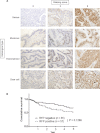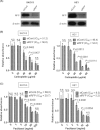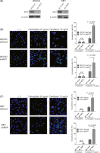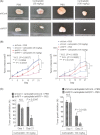Expression of RET finger protein predicts chemoresistance in epithelial ovarian cancer
- PMID: 23342271
- PMCID: PMC3544444
- DOI: 10.1002/cam4.32
Expression of RET finger protein predicts chemoresistance in epithelial ovarian cancer
Abstract
Resistance to platinum- and taxane-based chemotherapy is a major cause of treatment failure in ovarian cancer. Thus, it is necessary to develop a predictive marker and molecular target for overcoming drug resistance in ovarian cancer treatment. In a previous report, using an in vitro model, we found that the RET finger protein (RFP) (also known as tripartite motif-containing protein 27, TRIM27) confers cancer cell resistance to anticancer drugs. However, the significance of RFP expression in cancer patients remains elusive. In this study, we showed that RFP was expressed in 62% of ovarian cancer patients and its positivity significantly correlated with drug resistance. Consistent with clinical data, depletion of RFP by RNA interference (RNAi) in ovarian cancer cell lines, SKOV3 and HEY, significantly increased carboplatin- or paclitaxel-induced apoptosis and resulted in reduced anticancer drug resistance. In a nude mouse tumor xenograft model, inoculated RFP-knockdown ovarian cancer cells exhibited lower carboplatin resistance than control cells. These findings suggest that RFP could be a predictive marker for chemoresistance in ovarian cancer patients and also a candidate for a molecular-targeted agent.
Keywords: Carboplatin; RET finger protein; chemoresistance; epithelial ovarian cancer; paclitaxel.
Figures





Similar articles
-
[Effect of XPG down-regulation gene expression towards the proliferation of epithelial ovarian cancer cells and its chemosensitivity to platinum].Zhonghua Fu Chan Ke Za Zhi. 2012 Apr;47(4):286-91. Zhonghua Fu Chan Ke Za Zhi. 2012. PMID: 22781116 Chinese.
-
The impact of EpCAM expression on response to chemotherapy and clinical outcomes in patients with epithelial ovarian cancer.Oncotarget. 2017 Jul 4;8(27):44312-44325. doi: 10.18632/oncotarget.17871. Oncotarget. 2017. PMID: 28574829 Free PMC article.
-
MEK1 is associated with carboplatin resistance and is a prognostic biomarker in epithelial ovarian cancer.BMC Cancer. 2014 Nov 18;14:837. doi: 10.1186/1471-2407-14-837. BMC Cancer. 2014. PMID: 25408231 Free PMC article.
-
Metformin Improves Ovarian Cancer Sensitivity to Paclitaxel and Platinum-Based Drugs: A Review of In Vitro Findings.Int J Mol Sci. 2022 Oct 25;23(21):12893. doi: 10.3390/ijms232112893. Int J Mol Sci. 2022. PMID: 36361682 Free PMC article. Review.
-
Epigenetic mechanisms and therapeutic targets of chemotherapy resistance in epithelial ovarian cancer.Ann Med. 2015;47(5):359-69. doi: 10.3109/07853890.2015.1043140. Epub 2015 Jul 10. Ann Med. 2015. PMID: 26158617 Review.
Cited by
-
Role of tripartite motif protein 27 as a gametogenesis-related protein in human germ cells.Int J Clin Exp Pathol. 2017 Sep 1;10(9):9427-9435. eCollection 2017. Int J Clin Exp Pathol. 2017. PMID: 31966815 Free PMC article.
-
TRIM27 mediates STAT3 activation at retromer-positive structures to promote colitis and colitis-associated carcinogenesis.Nat Commun. 2018 Aug 24;9(1):3441. doi: 10.1038/s41467-018-05796-z. Nat Commun. 2018. PMID: 30143645 Free PMC article.
-
Suppression of REV7 enhances cisplatin sensitivity in ovarian clear cell carcinoma cells.Cancer Sci. 2014 May;105(5):545-52. doi: 10.1111/cas.12390. Epub 2014 Apr 7. Cancer Sci. 2014. PMID: 24597627 Free PMC article.
-
miR-30b-3p Inhibits Proliferation and Invasion of Hepatocellular Carcinoma Cells via Suppressing PI3K/Akt Pathway.Front Genet. 2019 Dec 13;10:1274. doi: 10.3389/fgene.2019.01274. eCollection 2019. Front Genet. 2019. PMID: 31921311 Free PMC article.
-
Intricate confrontation: Research progress and application potential of TRIM family proteins in tumor immune escape.J Adv Res. 2023 Dec;54:147-179. doi: 10.1016/j.jare.2023.01.011. Epub 2023 Feb 2. J Adv Res. 2023. PMID: 36736694 Free PMC article. Review.
References
-
- Jemal A, Siegel R, Xu J, Ward E. Cancer statistics, 2010. CA Cancer J. Clin. 2010;60:277–300. - PubMed
-
- Ferlay J, Shin HR, Bray F, Forman D, Mathers C, Parkin DM. Estimates of worldwide burden of cancer in 2008: GLOBOCAN 2008. Int. J. Cancer. 2010;127:2893–2917. - PubMed
-
- Engel J, Eckel R, Schubert-Fritschle G, Kerr J, Kuhn W, Diebold J, et al. Moderate progress for ovarian cancer in the last 20 years: prolongation of survival, but no improvement in the cure rate. Eur. J. Cancer. 2002;38:2435–2445. - PubMed
-
- Averette HE, Janicek MF, Menck HR. The National Cancer Data Base report on ovarian cancer. American College of Surgeons Commission on Cancer and the American Cancer Society. Cancer. 1995;76:1096–1103. - PubMed
Publication types
MeSH terms
Substances
LinkOut - more resources
Full Text Sources
Medical

